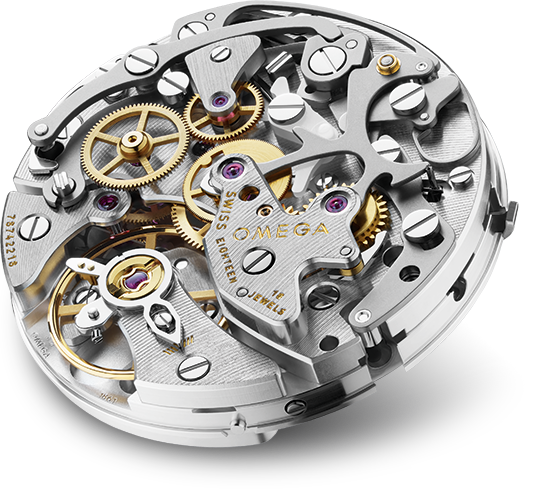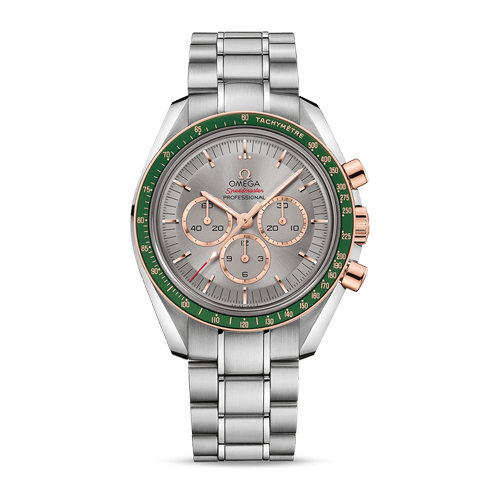Contact a boutique
For more information about this piece
Main menu
MyOmega menu
Watch Comparator ()
You have no watches to compare.
To start comparing, browse the collection of OMEGA watches.
Select between 2 to 4 watches to compare.

My OMEGA
I have an account
I don't have an account
Create a My OMEGA account to benefit from our exclusive services and keep up to date with our latest publications.
Collections menu
Breadcrumb
522.20.42.30.06.001
Sorry, but this watch is no longer available.
In celebration of the 2-year countdown to the Olympic Games Tokyo 2020, the event’s Official Timekeeper has produced this Speedmaster model, limited to 2,020 pieces.
Presented on a stainless steel bracelet, the 42 mm case has been created in stainless steel and 18K Sedna™ gold. The same 18K Sedna™ gold is used for the OMEGA logo, the hands and applied bevelled indexes, as well as the three subdial rings which are positioned on the sun-brushed grey dial. There is also an anthracite minute track.
The Speedmaster’s famous tachymeter scale is shown on a green anodized aluminium bezel ring. On the caseback, OMEGA has embossed the Tokyo 2020 logo, while inside, the famous OMEGA Calibre 1861 is included.
The chronograph function is a mechanism for measuring time intervals. A chronograph watch can therefore be used to time events while displaying the time like any traditional watch.
A series of watches whose production run is determined in advance of production and limited to a set number.
A hand on a sub-dial which tracks seconds typically it completes a full rotation in one minute.
A tachymeter watch has a function for measuring speed. It is a chronograph with a graduated dial on which speed can be read in kilometres per hour based on a 1000 metre distance.
This measures the space where a strap or bracelet would be placed.
This is the full length of the case, from the top lugs to the bottom lugs.
This is the full width of the watch’s case, excluding the crown and pushers.
When viewed from the side, this measures from the base of the watch to the surface of the glass.
For more information about this piece
Your request has been submitted successfully.
An OMEGA Boutique employee will contact you shortly.






1 / 4
OMEGA has been using the exclusive 18K SednaTM Gold, its own fiery rose gold alloy, since 2012. Named after Sedna, an orbiting planetoid that has been described as one of the reddest in the solar system, SednaTM Gold not only bears all the standard characteristics of other 18K golds, but it also offers high resistance to the fading of colour and lustre over time. Its unique composition includes copper and palladium for colour and stability.

2 / 4
Stainless steel is certainly the most conventional of watchmaking materials for outer craftsmanship, and offers beauty, strength and affordability. OMEGA uses 316L stainless steel. Known for its corrosion-resistance and high lustre after polishing, this material is often the ideal choice for watches in both daily-use and high-stress situations such as diving and adventure.

3 / 4
Aluminium has the advantage of being a truly lightweight material used for decorative components. Through anodisation, it offers an extensive range of colours for the creation of eye-catching watch parts such as bezel rings, applied elements on the dial, and hands. In particular, OMEGA’s special anodisation process has achieved aluminium bezel rings that are nearly double as hard as regular versions, therefore making them more resistant to outer damage.

4 / 4
To really appreciate the finer details of a timepiece, OMEGA uses synthetic sapphire crystal with a highly scratch-resistant and anti-reflective treatment. Before the machining and finishing processes take place, the sapphire crystals are produced under the Verneuil process, also called flame fusion. It involves the melting of the raw substance using oxyhydrogen flame and the crystallisation of the melted droplets to form a cylinder. Graded 9 on the Mohs-hardness scale (graded 1-10), the resulting sapphire crystals are virtually scratch-proof and very hard, ensuring an unhindered vision at all times.
OMEGA has been using the exclusive 18K SednaTM Gold, its own fiery rose gold alloy, since 2012. Named after Sedna, an orbiting planetoid that has been described as one of the reddest in the solar system, SednaTM Gold not only bears all the standard characteristics of other 18K golds, but it also offers high resistance to the fading of colour and lustre over time. Its unique composition includes copper and palladium for colour and stability.
Stainless steel is certainly the most conventional of watchmaking materials for outer craftsmanship, and offers beauty, strength and affordability. OMEGA uses 316L stainless steel. Known for its corrosion-resistance and high lustre after polishing, this material is often the ideal choice for watches in both daily-use and high-stress situations such as diving and adventure.
Aluminium has the advantage of being a truly lightweight material used for decorative components. Through anodisation, it offers an extensive range of colours for the creation of eye-catching watch parts such as bezel rings, applied elements on the dial, and hands. In particular, OMEGA’s special anodisation process has achieved aluminium bezel rings that are nearly double as hard as regular versions, therefore making them more resistant to outer damage.
To really appreciate the finer details of a timepiece, OMEGA uses synthetic sapphire crystal with a highly scratch-resistant and anti-reflective treatment. Before the machining and finishing processes take place, the sapphire crystals are produced under the Verneuil process, also called flame fusion. It involves the melting of the raw substance using oxyhydrogen flame and the crystallisation of the melted droplets to form a cylinder. Graded 9 on the Mohs-hardness scale (graded 1-10), the resulting sapphire crystals are virtually scratch-proof and very hard, ensuring an unhindered vision at all times.

Famous manual-winding chronograph movement. A descendent of the calibre that was worn on the Moon. Rhodium-plated finish.




